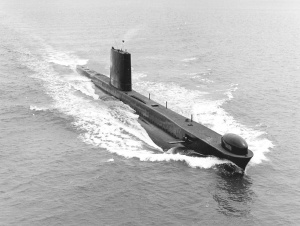British Porpoise-class submarine

|
|
| Class overview | |
|---|---|
| Name: | Porpoise |
| Builders: | |
| Operators: |
|
| Preceded by: | Explorer class |
| Succeeded by: | Oberon class |
| Built: | 1956–1959 |
| In service: | 1961-1980s |
| In commission: | 1956–1988 |
| Completed: | 8 |
| General characteristics | |
| Type: | Patrol/Attack submarine |
| Displacement: |
|
| Length: | 290 ft (88 m) |
| Beam: | 26 ft 7 in (8.10 m) |
| Draught: | 18 ft (5.5 m) |
| Propulsion: |
|
| Speed: |
|
| Range: | 9,000 nmi (17,000 km; 10,000 mi) at 12 kn (22 km/h; 14 mph) |
| Complement: | 71 |
| Armament: |
|
The Porpoise class was an eight-boat class of diesel-electric submarines operated by the Royal Navy. This class was originally designated patrol submarines, then attack. They were the first conventional British submarines to be built after the end of World War II. Their design was, in many ways, influenced by the German World War II-era Type XXI U-boats.
The Porpoise-class submarines were larger but shorter than their T-class predecessors and used a much improved steel known as UXW. This, and improved design and construction techniques allowed much deeper diving. It was found in tests that the unusually long engine room was liable to collapse, so there were extra large frames in this section, which proved to be something of an operational inconvenience.
Designed with a top speed of 18 knots (33 km/h; 21 mph), the boats were capable of 17 knots (31 km/h; 20 mph), or 16 knots (30 km/h; 18 mph) once fitted with silenced propellers. However, quieter running was felt to be a positive trade-off for the reduced speed. The Porpoise class were exceptionally quiet underwater, more so than their NATO counterparts and far more so than the Soviet Whiskeys. This was in part due to careful attention to detail in the mounting of machinery, and advances made in propeller design to prevent cavitation. Initially, the silenced propellers actually set up a distinctive resonant "singing", and it was said that Rorqual was once identified leaving the River Clyde from a listening station from Long Island. However, grooves were cut into the propellers and injected with a damping filler which cured the problem; Rorqual was later able to surface undetected off the Statue of Liberty. The silent running abilities made their sonar equipment particularly effective.
Each submarine's armament consisted of eight 21 inch (533 mm) torpedo tubes; six in the bow, and two in the stern. Initially, up to 30 Mark 8 or Mark 23 torpedoes were carried, although these were replaced in the 1970s by the Mark 24 Tigerfish torpedo. The class were also the first since the World War I-era R class to not carry a deck gun.
...
Wikipedia
